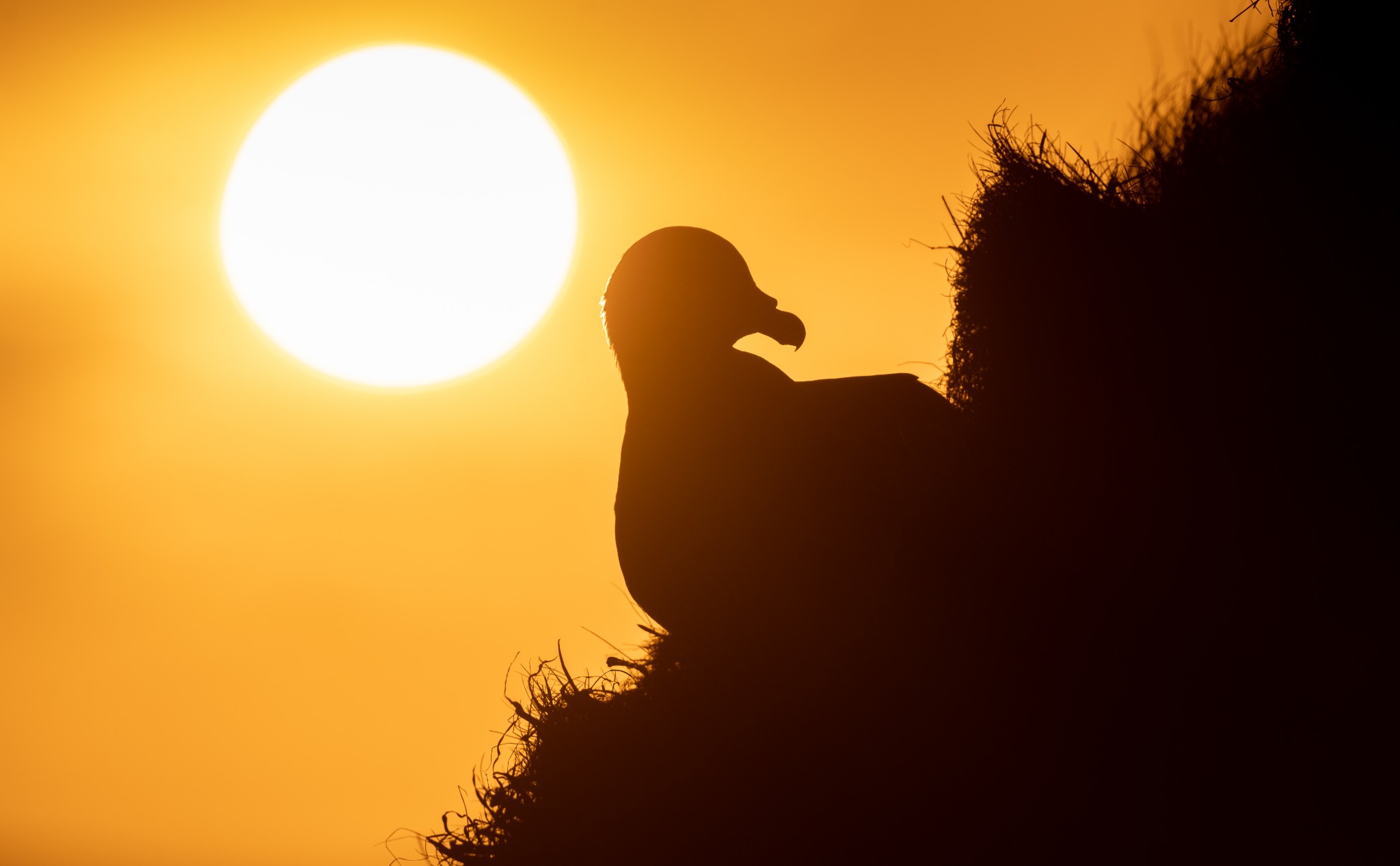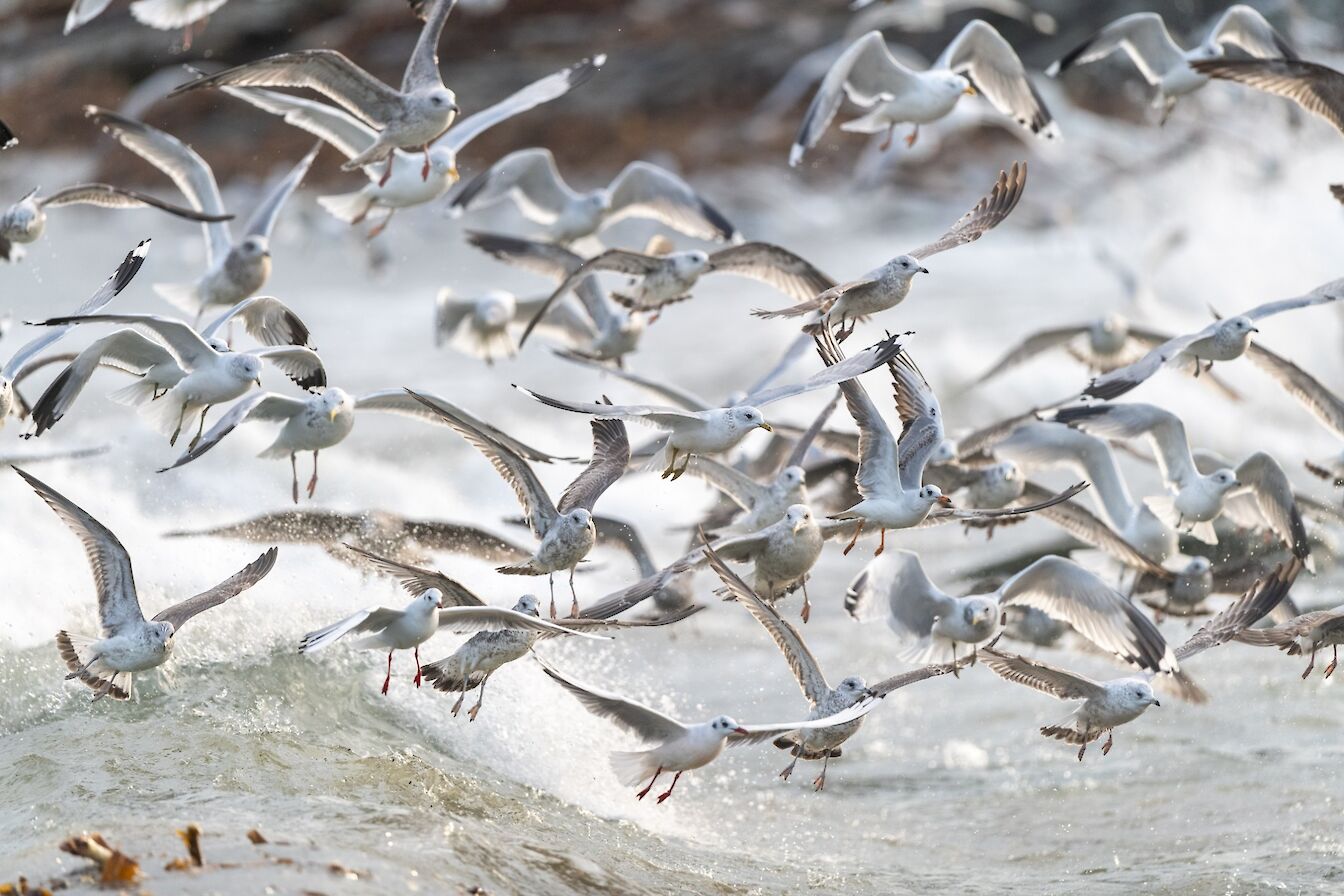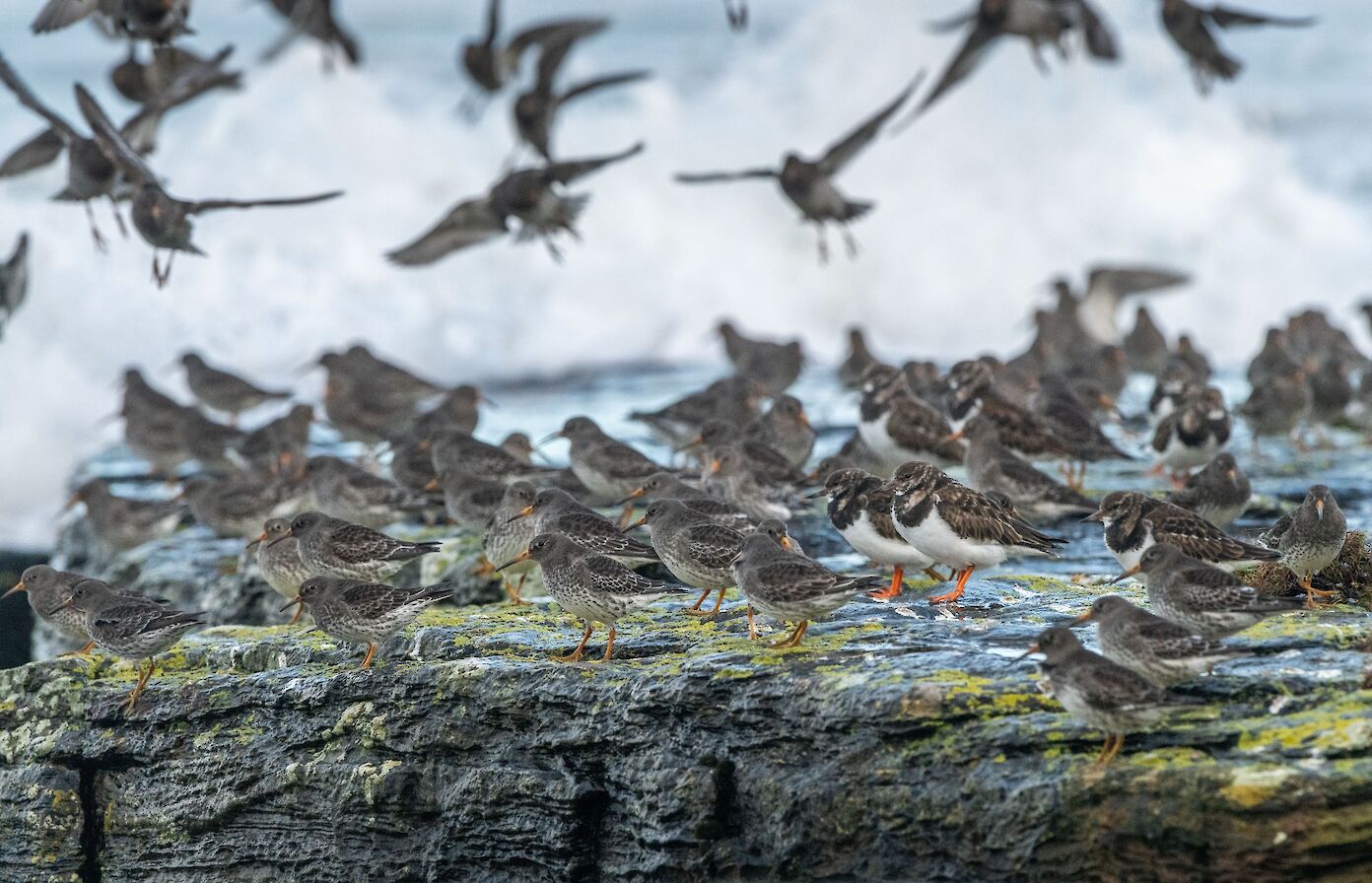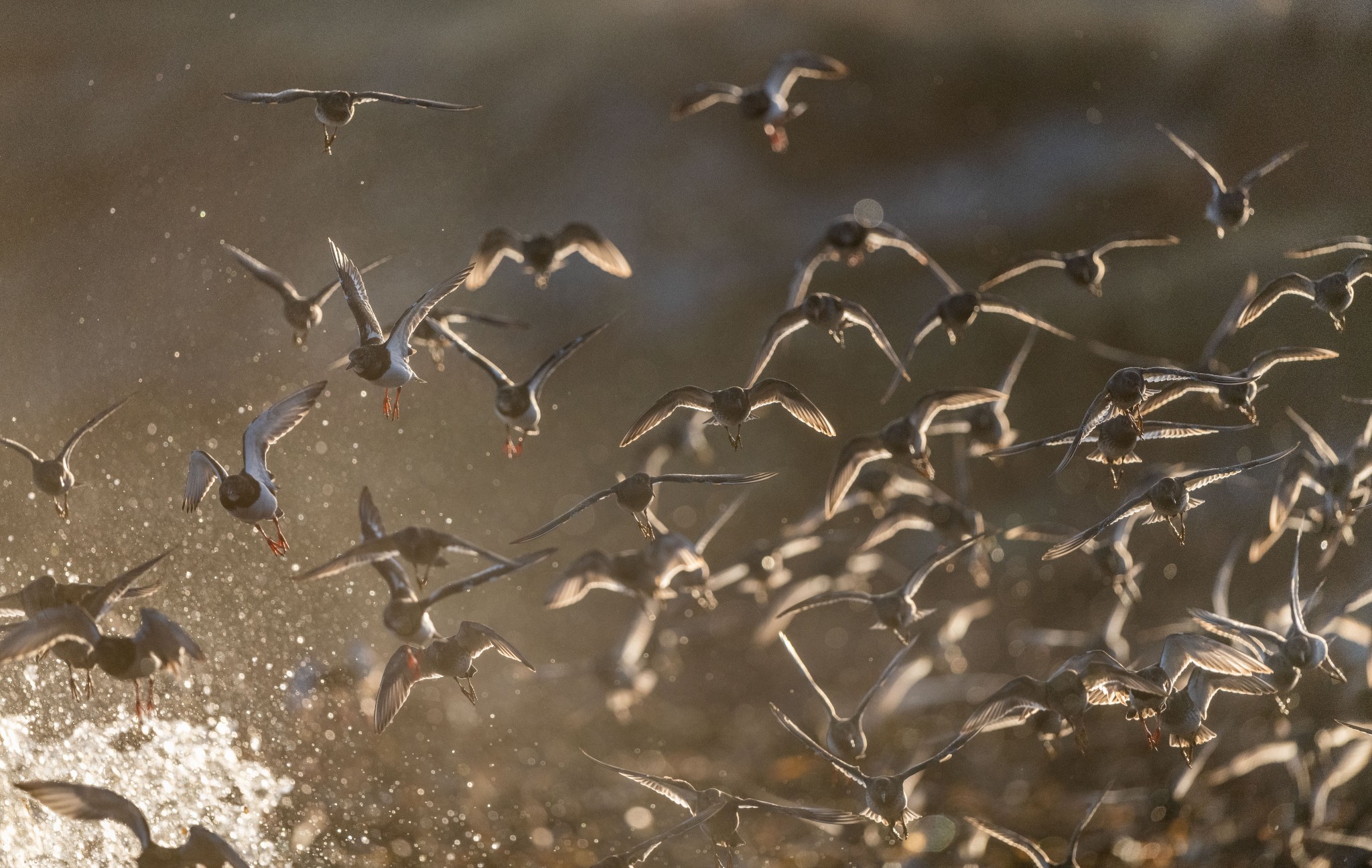The forecast is for sustained strong winds from the west, and as I approach Rapness ferry terminal in Westray I have a sense of anticipation of what kind of images I might get over the coming days.
My plan is a simple one, photograph the perfect little storm bird, the purple sandpiper, dodging the crashing surf, picking amongst the rocks and kelps for invertebrates and other morsels.
As I drive off the ferry though I’m met with something quite different, it’s a rather nice day!
A pale, yellow sky is developing, the sun still just a white sliver over the south east. It’s sheltered here and a small group of fulmars are resting on the cliff along the shore. I’ve already formed an idea in my mind of what kind of image this opportunity presents - now I just need to try and execute it. The sun is full and climbing rapidly and I know that if I can frame it with a long telephoto lens then it will appear large in my frame. If I can make it around to an angle where the sun is rising behind one of the fulmars then I can silhouette it and that would be pretty cool.
Time is against me, but I don’t want to rush. Although a common and familiar bird, I know that fulmars at this time of year are much more skittish than those in the summer. If I move without caution it will simply fly off and the opportunity will be lost. I’m at too strange an angle to use a tripod, the 500mm lens is heavy to hand hold and so I simply let the camera take control. I want a silhouette of the fulmar, so choose aperture priority. I’m shooting straight into a very bright scene and so the camera automatically under exposes as a result. I can still shoot with a low ISO and high shutter speed in this scene and avoid any camera shake. The sky is now a wonderful rich sunflower colour and the image in my viewfinder looks exactly like I’d hoped.
I’ve only been in Westray for half an hour and I’m already more than happy with an image I’ve made. I think to myself that If I got back on the next ferry instead of staying for a few days then I would be happy, and it’s not very often that happens!
Content, I head north to try and find the bird I actually came here when something dawns on me. It potentially has big ramifications for what I want to achieve and will make life much harder for me if the weather conditions and light deteriorate. I’ve forgotten my tripod plate in Kirkwall. Normally I always have it attached to the bottom of my 500mm lens precisely so that I don’t forget it, but the previous day I had been lying on the sand photographing shells on the beach and took it off to clean it. This isn’t ideal.
As I approach a secluded bay on Westray’s east coast my eyes light up and I can see image after image, and I’m desperate to get going. More by chance than design I’ve arrived at the perfect time. The tide is almost fully in, but not quite. A heavy easterly swell is driving curling waves towards big banks of kelps on the shore. The bay is quite simply alive with birds.
Most obvious are the mixed flocks of hundreds of gulls - herring, black headed, common and great black back, screaming noisily as they rise above thundering spray. The sky is full of starlings, thousands of them, swirling, rising, always on the move. The starling is as much a shore bird in Orkney as it is a garden bird.
Then I see them, though they’re not quite as obvious at first. Purple sandpipers, my storm bird, frantic amongst the kelp stipes. Fortunately, they are approachable and I tuck myself down on the shore at the edge of the cast kelp and wait for them to come to me. I soon have a problem though; the sun has disappeared and I find myself cursing my forgetfulness. I’m now shooting a small dark bird against a dark kelpy background. I have to push my ISO higher than I would like in order to get a half decent shutter speed.
There is so much happening on the shore - waves crashing, wheeling fulmars, squabbling gulls, chattering starlings. It’s as if there are wings everywhere. Often the purple sandpiper has a partner in crime, the turnstone, and they are here in good numbers too.
As the tide rises, the waves seem heavier, the waders now have to climb above them to avoid getting swamped. The sun breaks through a laden sky and as the sandpipers rise and they look beautifully backlit.
I’ve been lucky enough to film wildlife all around the world but here I’m in my element.
Big seas, thousands of birds and an electric energy, I couldn’t be any happier. As the waders make their way towards me, I can get a really good look at the sandpipers. In this light I can just see a very faint purple sheen on the back of the bird but it disappears as the sun fades. You’re more likely to see the subtle purple colouring as spring turns to summer and as the birds are ready to head off to their Arctic breeding grounds.
I love their plumage; the grey isn’t boring and to me the pattern looks a little like a Fair Isle jumper. It contrasts beautifully with their vibrant orange bill and legs. Flocks of around 100 birds are taking off from the kelp, circling out to sea and landing frustratingly at the other side of the bay. The temptation is to follow them but it’s best to hold your nerve. Sure enough, another wave moves them off their rocky slab and after a circuit of the bay they are back in front of me.
There’s a reason there are so many birds here - food. It’s only when I zoom into the image on the back of my camera that is see what is going on. I focus on some turnstones picking away and see that the wave that is now slowly draining away is absolutely full of kelp fly larvae, the perfect little packet of fuel for waders, starlings and gulls alike. Kelp flies lay their eggs in the rotting kelp now cast upon the shore which develop into larvae. But now the high tide is flushing it out of the weed and into the water column, thrown back across the rocks and weed with each incoming wave. It’s easy pickings.
I get a reminder that I need to be careful, the waves are fairly coming in and I have to move quickly, just like those purple sandpipers, jumping up a ledge to avoid getting soaked. As the tide recedes the atmosphere and mood on the shore also changes. There are new feeding opportunities further down the shore and so birds start to disperse. Some sandpipers have started preening, the turnstones have begun to gather on rocks offshore and the starlings have left for nearby rooftops.
I leave too and head for Grobust in the north of the island. The predicted weather does live up to expectations here, the beautiful turquoise waves so characteristic of this beach are rolling in with black skies beyond. I put the camera down and realise that I’ve been shooting almost nonstop for six hours. I’ve forgotten to have lunch in the process, so it’s a perfect opportunity to just rest and admire those waves and do it all again tomorrow.
Find out more about Raymond’s work via his official website. You can also find him on Facebook, Twitter and Instagram.




